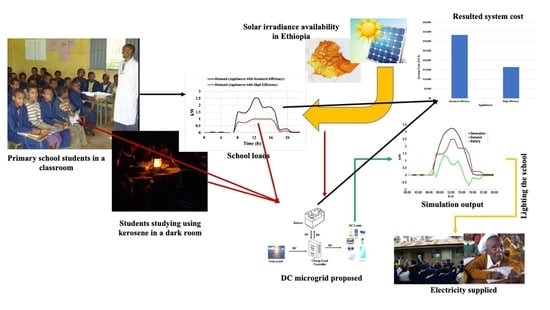Design and Modeling of a Standalone DC-Microgrid for Off-Grid Schools in Rural Areas of Developing Countries
Abstract
1. Introduction
1.1. Motivation
1.2. Related Works
1.3. Contribution
1.4. Background Data and Load Estimation
1.4.1. School Data
1.4.2. Load Estimation
1.5. Paper Organization
2. Microgrids
2.1. AC Microgrid
2.2. DC Microgrid
3. Design and Model of DC Microgrid
3.1. PV Power System
3.2. Battery Storage System
3.3. System Modeling and Design Using MATLAB/Simulink
4. Results
4.1. Validation of MATLAB/Simulink Model
4.2. Simulation
4.3. Cost Analysis
5. Conclusions
Author Contributions
Funding
Acknowledgments
Conflicts of Interest
References
- Al Mamun, K.; Amanullah, M.T.O. Smart Energy Grid Design for Island Countries: Challenges and Opportunities; Springer: Berlin/Heidelberg, Germany, 2018. [Google Scholar]
- COVID-19 Reverses Electricity Access Progress. Available online: https://www.iea.org/reports/sdg7-data-and-projections/access-to-electricity (accessed on 20 November 2020).
- Prinsloo, G.; Mammoli, A.; Dobson, R. Customer domain supply and load coordination: A case for smart villages and transactive control in rural off-grid microgrids. Energy 2017, 135, 430–441. [Google Scholar] [CrossRef]
- United Nations. UN Sustainable Development Goals. Available online: https://sustainabledevelopment.un.org/ (accessed on 18 September 2020).
- Roy, A.; Kabir, M.A. Relative life cycles economic analysis of stand-alone solar PV and fossil fuel-powered systems in Bangladesh concerning load demand and market controlling factors. Renew. Sustain. Energy Rev. 2012, 16, 4629–4637. [Google Scholar] [CrossRef]
- Adefarati, T.; Bansal, R.C. Reliability and economic assessment of a microgrid power system with the integration of renewable energy resources. Appl. Energy 2017, 206, 11–33. [Google Scholar] [CrossRef]
- Adefarati, T.; Bansal, R.C.; Justo, J.J. Reliability and economic evaluation of a microgrid power system. Energy Procedia 2017, 142, 43–48. [Google Scholar] [CrossRef]
- Dawoud, S.M.; Lin, X.; Okba, M.I. Hybrid renewable microgrid optimization techniques: A review. Renew. Sustain. Energy Rev. 2018, 82, 2039–2052. [Google Scholar] [CrossRef]
- Boait, P.; Advani, V.; Gammon, R. Estimation of demand diversity and daily demand profile for off-grid electrification in developing countries. Energy Sustain. Dev. 2015, 29, 135–141. [Google Scholar] [CrossRef]
- Nosratabadi, S.M.; Hooshmand, R.A.; Gholipour, E. A comprehensive review on microgrid and virtual power plant concepts employed for distributed energy resources scheduling in power systems. Renew. Sustain. Energy Rev. 2017, 67, 341–363. [Google Scholar] [CrossRef]
- IRENA. Global Energy Transformation: A Roadmap to 2050, 2019 ed.; International Renewable Energy Agency: Abu Dhabi, UAE, 2019. [Google Scholar]
- Davies, G.; Currie, C.; Young, E. Impacts of Solar PV on Teacher Satisfaction’ University of Strathclyde. 2015. Available online: https://www.drop-box.com/sh/m2wgfi7ev4wyet2/AAB5PZ9AX-3dLPu7rZFIWIWK2a?dl=0 (accessed on 25 September 2020).
- UNDESA. Electricity and Education: The Benefits, Barriers, and Recommendations for Achieving the Electrification of Primary and Secondary Schools. 2014. Available online: https://docs.google.com/gview?url=http://sustainabledevelopment.un.org/content/documents/1608Electricity%20and%20Education.pdf&embedded=true (accessed on 25 September 2020).
- Van Gevelt, C.T.; Canales Holzeis, S.; Fennell, B.; Heap, J.; Holmes, M.H.; Depret, B.; Jones, M.T. Safdar. Achieving universal energy access and rural development through smart villages. Energy Sustain. Dev. 2018, 43, 139–142. [Google Scholar] [CrossRef]
- Estefanía Planas, J.A. AC and DC technology in microgrids: A review. Renew. Sustain. Energy Rev. 2015, 43, 726–749. [Google Scholar] [CrossRef]
- State of the Global Mini-Grids Market Report 2020. Available online: https://minigrids.org/wp-content/uploads/2020/06/Mini-grids-Market-Report-20.pdf (accessed on 18 November 2020).
- Aemro, Y.B.; Moura, P.; de Almeida, A.T. DC-Microgrids As a Means of Rural Development in East African Countries. In ASME Power Conference; (ASME 2018 Power Conference collocated with the ASME 2018 12th International Conference on Energy Sustainability and the ASME 2018 Nuclear Forum, Lake Buena Vista, FL, USA, 24–28 June 2018); Volume 1: Fuels, Combustion, and Material Handling; Combustion Turbines Combined Cycles; Boilers and Heat Recovery Steam Generators; Virtual Plant and Cyber-Physical Systems; Plant Development and Construction; Renewable Energy Systems; ASME: Tallahassee, FL, USA, 2018; pp. 1–9. [Google Scholar] [CrossRef]
- Decuir, J.; Michael, P. Draft IEEE Standard for DC Microgrids for Rural and Remote Electricity Access Applications. 1 April 2020. Available online: https://standards.globalspec.com/std/14313932/ieee-p2030-10-draft (accessed on 15 November 2020).
- World Bank/Ethiopia Report ETHIOPIA|Beyond Connections: Energy Access Diagnostic Report Based on the Multi-Tier Framework. 2018. Available online: https://www.powermag.com/wp-content/uploads/2020/08/ethiopia-national-electrification-program.pdf (accessed on 2 December 2020).
- National Electrification Program 2.0: Integrated Planning for Universal Access. ብርሃን ለሁሉ (Light to All); Addis Ababa, Ethiopia, 2019; Available online: https://openknowledge.worldbank.org/handle/10986/30102 (accessed on 2 December 2020).
- IEG. The Welfare Impact of Rural Electrification: A Reassessment of the Costs and Benefits’ World Bank Independent Evaluation Group. 2008. Available online: https://openknowledge.worldbank.org/handle/10986/6519 (accessed on 13 November 2020).
- Tanzsolar. Tegaruka School. 2012. Available online: http://www.tanzsolar.org/tegaruka.html (accessed on 13 November 2020).
- Diniz, A.S.A.C.; França, E.D.; Câmara, C.F.; Morais, P.M.R.; Vilhena, L. The Important Contribution of Photovoltaics in a Rural School Electrification Program. In Proceedings of the 2006 IEEE 4th World Conference on Photovoltaic Energy Conference, Waikoloa, HI, USA, 7–12 May 2006; Volume 2, pp. 2528–2531. [Google Scholar]
- Welland, A. Education and the electrification of rural schools, Technical Report 13, Smart Villages (2017). Available online: https://sun-connect-news.org/fileadmin/DATEIEN/Dateien/New/TR13-Education-and-the-Electrification-of-Rural-Schools_web-1.pdf (accessed on 2 December 2020).
- Kammen, D.M.; Mills, A. Community-Based Electric Micro-Grids Can Contribute to Rural Development: Evidence from Kenya. World Dev. 2009, 37, 1208–1221. [Google Scholar]
- Khodayar, M.E. Rural electrification and expansion planning of off-grid microgrids. Electr. J. 2017, 30, 68–74. [Google Scholar] [CrossRef]
- Veilleux, G.; Potisat, T.; Pezim, D.; Ribback, C.; Ling, J.; Krysztofinski, A.; Ahmed, A.; Papenheim, J.; Pineda, A.M.; Sembian, S.; et al. Techno-economic analysis of microgrid projects for rural electrification: A systematic approach to the redesign of Koh Jik off- grid case study. Energy Sustain. Dev. 2020, 54, 1–13. [Google Scholar] [CrossRef]
- Adefarati, T.; Bansal, R.C. Reliability, economic and environmental analysis of a microgrid system in the presence of renewable energy resources. Appl. Energy 2019, 236, 1089–1114. [Google Scholar] [CrossRef]
- Nnaji, E.C.; Adgidzi, D.; Dioha, M.O.; Ewim, D.R.E.; Huan, Z. Modelling and management of smart microgrid for rural electrification in sub-Saharan Africa: The case of Nigeria. Electr. J. 2019, 32, 106672. [Google Scholar] [CrossRef]
- Kitson, J.; Williamson, S.J.; Harper, P.W.; McMahon, C.A.; Rosenberg, G.; Tierney, M.J.; Bell, K.; Gautam, B. Modeling of an expandable, reconfigurable, renewable DC microgrid for off-grid communities. Energy 2018, 160, 142–153. [Google Scholar] [CrossRef]
- Chauhan, R.K.; Chauhan, K.; Subrahmanyam, B.R.; Singh, A.G.; Garg, M.M. Distributed and centralized autonomous DC microgrid for residential buildings: A case study. J. Build. Eng. 2020, 27, 100978. [Google Scholar] [CrossRef]
- Jafari, R.; Derakhshandeh, S.Y.; Baharizadeh, M.; Fadaei, M. The Possibility of DC Microgrids Establishment in Remote and Rural Places. In Proceedings of the 2015 20th Conference on Electrical Power Distribution Networks Conference (EPDC), Zahedan, Iran, 28–29 April 2015. [Google Scholar] [CrossRef]
- Nasir, M.; Khan, H.A.; Hussain, A.; Mateen, L.; Zaffar, N.A. Solar PV-Based Scalable DC Microgrid for Rural Electrification in Developing Regions. IEEE Trans. Sustain. Energy 2018, 9, 390–399. [Google Scholar] [CrossRef]
- Saha, S.; Bhattacharjee, A.; Elangovan, D.; Arunkumar, G. DC Microgrid System for Rural Electrification. In Proceedings of the 2017 International Conference on Energy, Communication, Data Analytics and Soft Computing (ICECDS), Chennai, India, 1–2 August 2017. [Google Scholar] [CrossRef]
- Ghenai, C.; Bettayeb, M. Design and optimization of grid-tied and off-grid solar PV systems for super-efficient electrical appliances. Energy Effic. 2020, 13, 291–305. [Google Scholar] [CrossRef]
- Ssennoga, T.; Makbul, A.M.R. A review of optimization approaches for hybrid distributed energy generation systems: Off-grid and grid-connected systems. Sustain. Cities Soc. 2018, 41, 320–331. [Google Scholar]
- Efficiency for Access. Off-Grid Appliance Data Platform. Available online: https://efficiencyforaccess.org/data-platform (accessed on 14 November 2020).
- Lai, E.; Muir, S.; Erboy Ruff, Y. Off-grid appliance performance testing: Results and trends for early-stage market development. Energy Effic. 2020, 13, 323–347. [Google Scholar] [CrossRef]
- De Almeida, A.; Moura, P.; Quaresma, N. Energy-efficient off-grid systems—Review. Energy Effic. 2020, 13, 349–376. [Google Scholar] [CrossRef]
- Madduri, P.A.; Poon, J.; Rosa, J.; Podolsky, M.; Brewer, E.A.; Sanders, S.R. Scalable DC Microgrids for Rural Electrification in Emerging Regions. IEEE J. Emerg. Sel. Top. Power Electron. 2016, 4, 1195–1205. [Google Scholar] [CrossRef]
- Tembo, K.; Mafuta, M. Solar PV Strategic Energy project in Southern Malawi: Development, Design and Impact: Case Study. University of Strathclyde. 2015. Available online: https://www.dropbox.com/sh/m2wgfi7ev4wyet2/AAB-5PZ9AX3dLPu7rZFIWIWK2a?dl=0 (accessed on 20 September 2020).
- Global LEAP Awards: 2017 Buyer’s Guide for Off-Grid Fans and Televisions; Global Lighting and Energy Access Partnership (Global LEAP). 2017. Available online: https://storage.googleapis.com/e4a-website-assets/2017-Global-LEAP-Buyers-Guide-TVs-and-Fans-August-2017.pdf (accessed on 15 September 2020).
- Solar Development PLC. Solar DC Lamps. 2019. Available online: https://www.soldev.net/?page_id=1842 (accessed on 25 November 2019).
- Seiko Epson Corporation. Energy Consumption. 2019. Available online: https://www.epson.eu/energy-consumption (accessed on 25 November 2019).
- Dragon Systems Software Limited (DssW). Review of Computer Energy Consumption and Potential Savings. 2019. Available online: https://www.dssw.co.uk/research/computer_energy_consumption.html#_Toc29375313 (accessed on 27 November 2019).
- Ghadimi, N.; Nojavan, S.; Abedinia, O.; Dehkordi, A.B. Deterministic-Based Energy Management of DC Microgrids. In Risk-Based Energy Management; Academic Press: Cambridge, MA, USA, 2020; pp. 11–30. [Google Scholar]
- Jackson, J.J.; Francis, M.; Ju, L.; Jin-Woo, J. AC-microgrids versus DC-microgrids with distributed energy resources: A review. Renew. Sustain. Energy Rev. 2013, 24, 387–405. [Google Scholar]
- Laaksonen, H.J. Protection Principles for Future Microgrids. IEEE Trans. Power Electron. 2010, 25, 2910–2918. [Google Scholar] [CrossRef]
- Lonkar, M.; Ponnaluri, S. An Overview of DC Microgrid Operation and Control. In Proceedings of the IREC2015 The Sixth International Renewable Energy Congress, Sousse, Tunisia, 24–26 March 2015; pp. 1–6. [Google Scholar] [CrossRef]
- Kanellos, F.D.; Hatziargyriou, N.D. Control of variable speed wind turbines equipped with synchronous or doubly fed induction generators supplying islanded power systems. IET Renew. Power Gener. 2009, 3, 96–108. [Google Scholar] [CrossRef]
- Praiselin, W.J.; Edward, J.B. Integrated Renewable Energy Sources with Droop Control Techniques-Based Microgrid Operation. In Hybrid-Renewable Energy Systems in Microgrids; Woodhead Publishing: Sawston/Cambridge, UK, 2018; pp. 39–60. [Google Scholar] [CrossRef]
- Lopes, J.A.P.; Moreira, C.L.; Madureira, A.G. Defining control strategies for Microgrids islanded operation. IEEE Trans. Power Syst. 2006, 21, 916–924. [Google Scholar] [CrossRef]
- Pogaku, N.; Prodanovic, M.; Green, T.C. Modeling, analysis and testing of autonomous oper- ation of an inverter-based microgrid. IEEE Trans. Power Electron. 2007, 22, 613–625. [Google Scholar] [CrossRef]
- El-Shahat, A.; Sumaiya, S. DC-Microgrid System Design, Control, and Analysis. Electronics 2019, 8, 124. [Google Scholar] [CrossRef]
- Dragičević, T.; Li, Y. AC and DC Microgrid Control. In Control of Power Electronic Converters and Systems; Academic Press: Cambridge, MA, USA, 2018; pp. 167–200. [Google Scholar] [CrossRef]
- Xu, L.; Chen, D. Control and operation of a DC microgrid with variable generation and energy storage. IEEE Trans. Power Deliv. 2011, 26, 2513–2522. [Google Scholar] [CrossRef]
- Arif, M.S.B.; Hasan, M.A. Microgrid Architecture, Control, and Operation. In Hybrid-Renewable Energy Systems in Microgrids; Woodhead Publishing: Sawston/Cambridge, UK, 2018; pp. 23–37. [Google Scholar] [CrossRef]
- Cairoli, P.; Dougal, R.A. New Horizons in DC Shipboard Power Systems: New Fault Protection Strategies Are Essential to the Adoption of dc Power Systems. In Electrification Magazine; IEEE: Piscataway, NJ, USA, 2013; Volume 1, pp. 38–45. [Google Scholar]
- Chauhan, R.K.; Rajpurohit, B.S.; Hebner, R.E.; Singh, S.N.; Gonzalez-Longatt, F.M. Voltage standardization of DC distribution system for residential buildings. J. Clean Energy Technol. 2016, 4, 167–172. [Google Scholar] [CrossRef]
- Chauhan, R.K.; Rajpurohit, B.S.; Hebner, R.E.; Singh, S.N.; Longatt, F.M.G. Design and Analysis of PID and Fuzzy-PID Controller for Voltage Control of DC Microgrid. In Proceedings of the IEEE PES Innovative Smart Grid Technologies (ISGT) Asian Conference, Bangkok, Thailand, 3–6 November 2015; pp. 1–6. [Google Scholar]
- Available online: http://pubdocs.worldbank.org/en/992231461105688203/Ethiopia-Wind-Resource-Poster-Landscape-WB-ESMAP-Apr2016.pdf (accessed on 15 November 2020).
- Bekele, G.; Tadesse, G. Feasibility study of small Hydro/PV/Wind hybrid system for off-grid rural electrification in Ethiopia. Appl. Energy 2012, 97, 5–15. [Google Scholar] [CrossRef]
- Kebede, M.H.; Beyene, G.B. Feasibility Study of PV-Wind-Fuel Cell Hybrid Power System for Electrification of a Rural Village in Ethiopia. J. Electr. Comput. Eng. 2018. [Google Scholar] [CrossRef]
- PVWatts Calcualtor. Available online: https://pvwatts.nrel.gov/pvwatts.php (accessed on 25 January 2020).
- Sirsi, R.; Ambekar, Y. Efficiency of DC Microgrid on DC Distribution System. In Proceedings of the 2015 IEEE Innovative Smart Grid Technologies—Asia (ISGT ASIA), Bangkok, Thailand, 3–6 November 2015; pp. 1–6. [Google Scholar] [CrossRef]
- Battke, B.; Schmidt, T.S. Cost-efficient demand-pull policies for multi-purpose technologies–The case of stationary electricity storage. Appl. Energy 2015, 155, 334–348. [Google Scholar] [CrossRef]
- Das, B.K.; Al-Abdeli, Y.M.; Kothapalli, G. Optimization of stand-alone hybrid energy systems supplemented by combustion-based prime movers. Appl. Energy 2017, 196, 18–33. [Google Scholar] [CrossRef]
- Ramli, M.A.M.; Bouchekara, H.R.E.H.; Alghamdi, A.S. Optimal sizing of PV/wind/diesel hybrid microgrid system using multi-objective self-adaptive differential evolution algorithm. Renew. Energy 2018, 121, 400–411. [Google Scholar] [CrossRef]
- Fregosi, D.; Ravula, S.; Brhlik, D.; Saussele, J.; Frank, S.; Bonnema, E.; Jennifer, S.; Wilson, E. A Comparative Study of DC and AC Microgrids in Commercial Buildings across Different Climates and Operating Profiles. In Proceedings of the 2015 IEEE First International Conference on DC Microgrids (ICDCM), Atlanta, GA, USA, 24–27 May 2015; pp. 159–164. [Google Scholar] [CrossRef]
- IRENA. Solar PV in Africa: Costs and Markets; IRENA: Abu Dhabi, UAE, 2016. [Google Scholar]
- Lockhart, E.; Li, X.; Booth, S.; Salasovich, J.; Olis, D.; Elsworth, J.; Lisell, L. Comparative Study of Techno-Economics of Lithium-Ion and Lead-Acid Batteries in Micro-Grids in Sub-Saharan Africa: Technical Report NREL/TP-7A40-73238; National Renewable Energy Laboratory: Golden, CO, USA, 2019. Available online: https://www.nrel.gov/docs/fy19osti/73238.pdf (accessed on 10 October 2020).
- Phadke, A.; Park, W.Y.; Abhyankar, N. Providing reliable and financially sustainable electricity access in India using super-efficient appliances. Energy Policy 2019, 132, 1163–1175. [Google Scholar] [CrossRef]
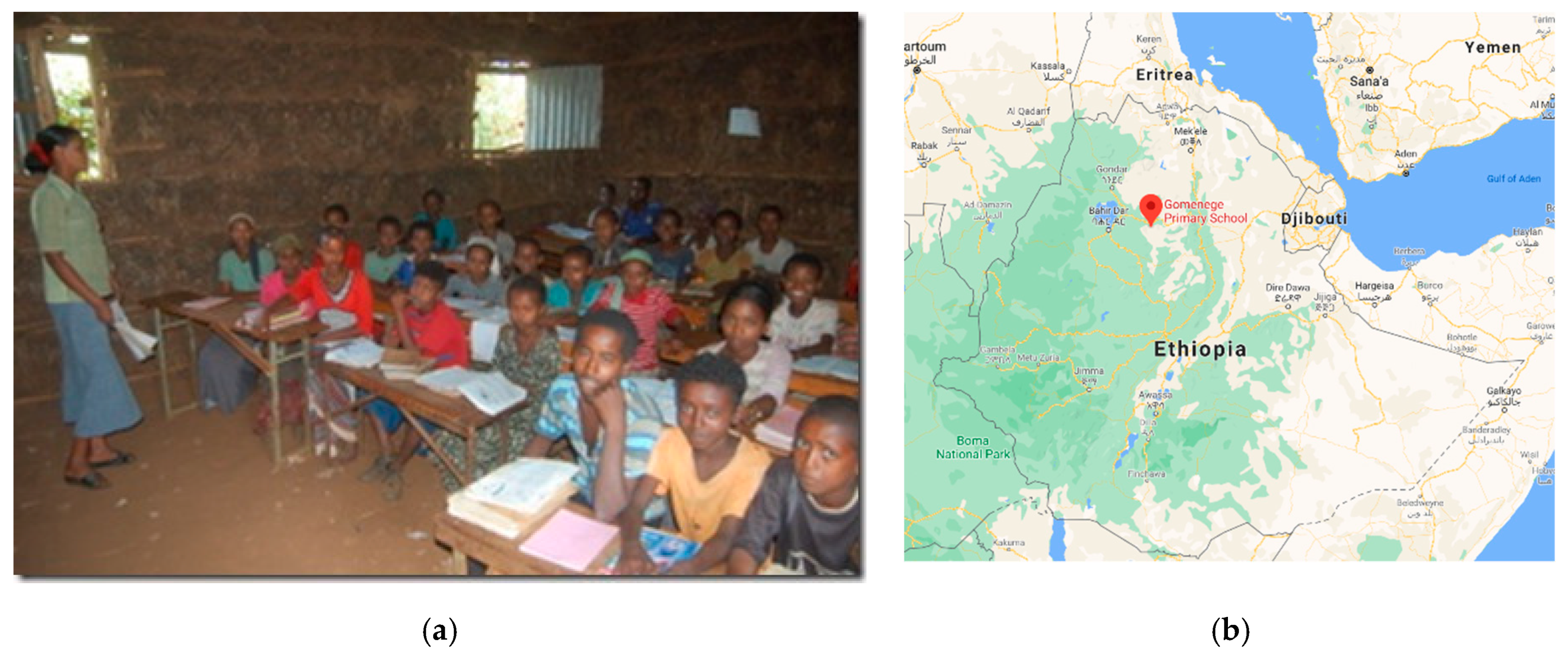
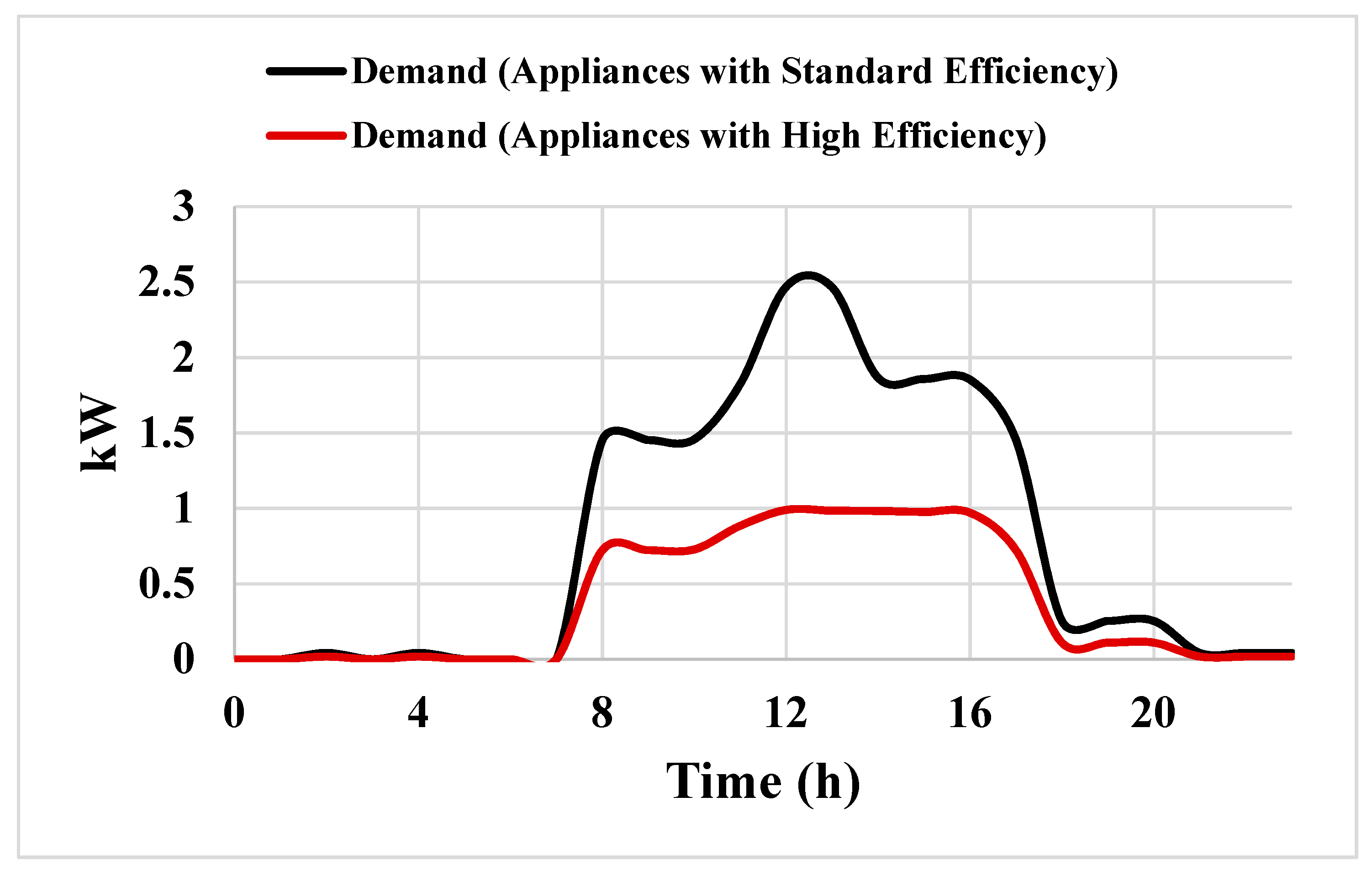
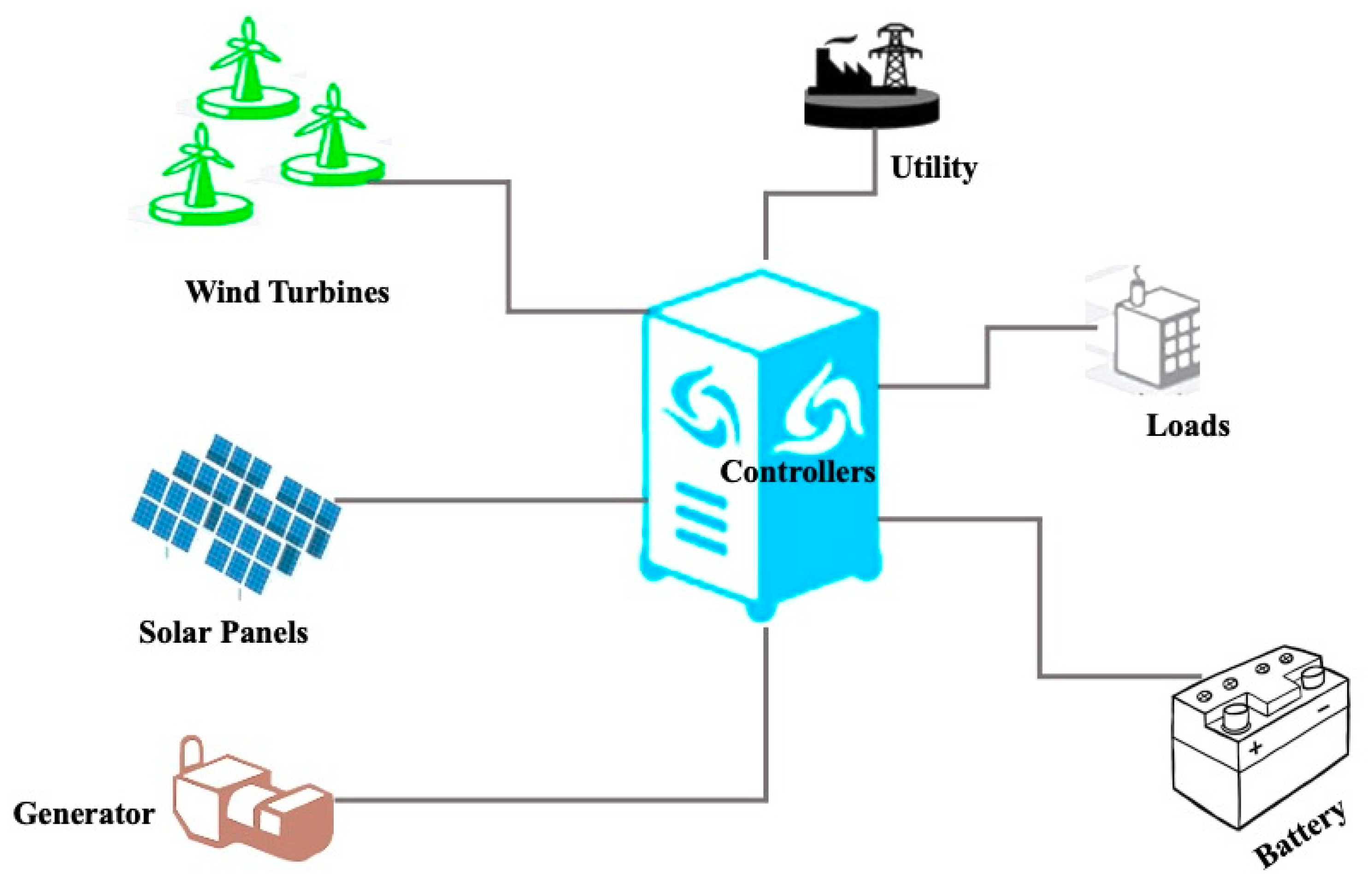
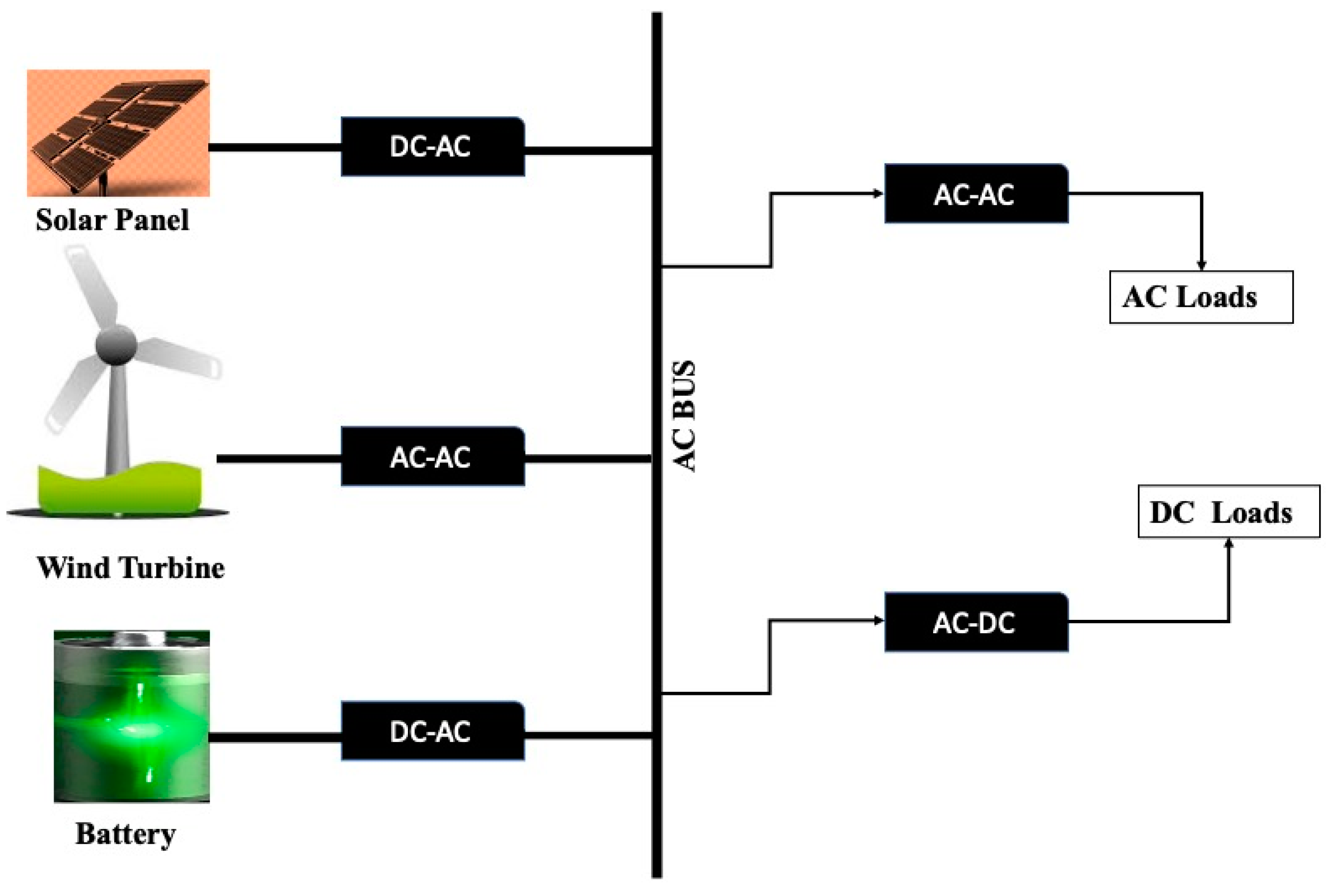
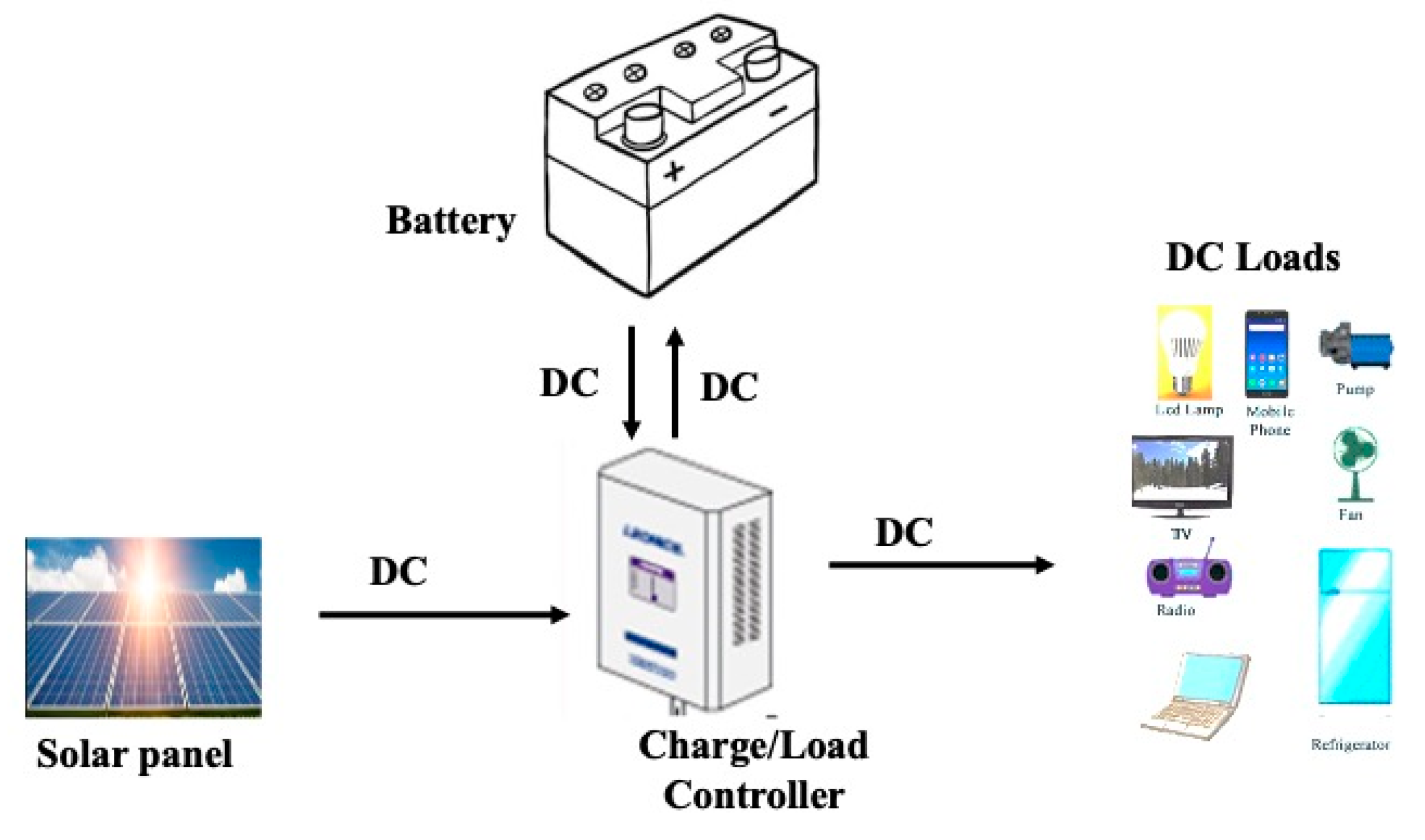

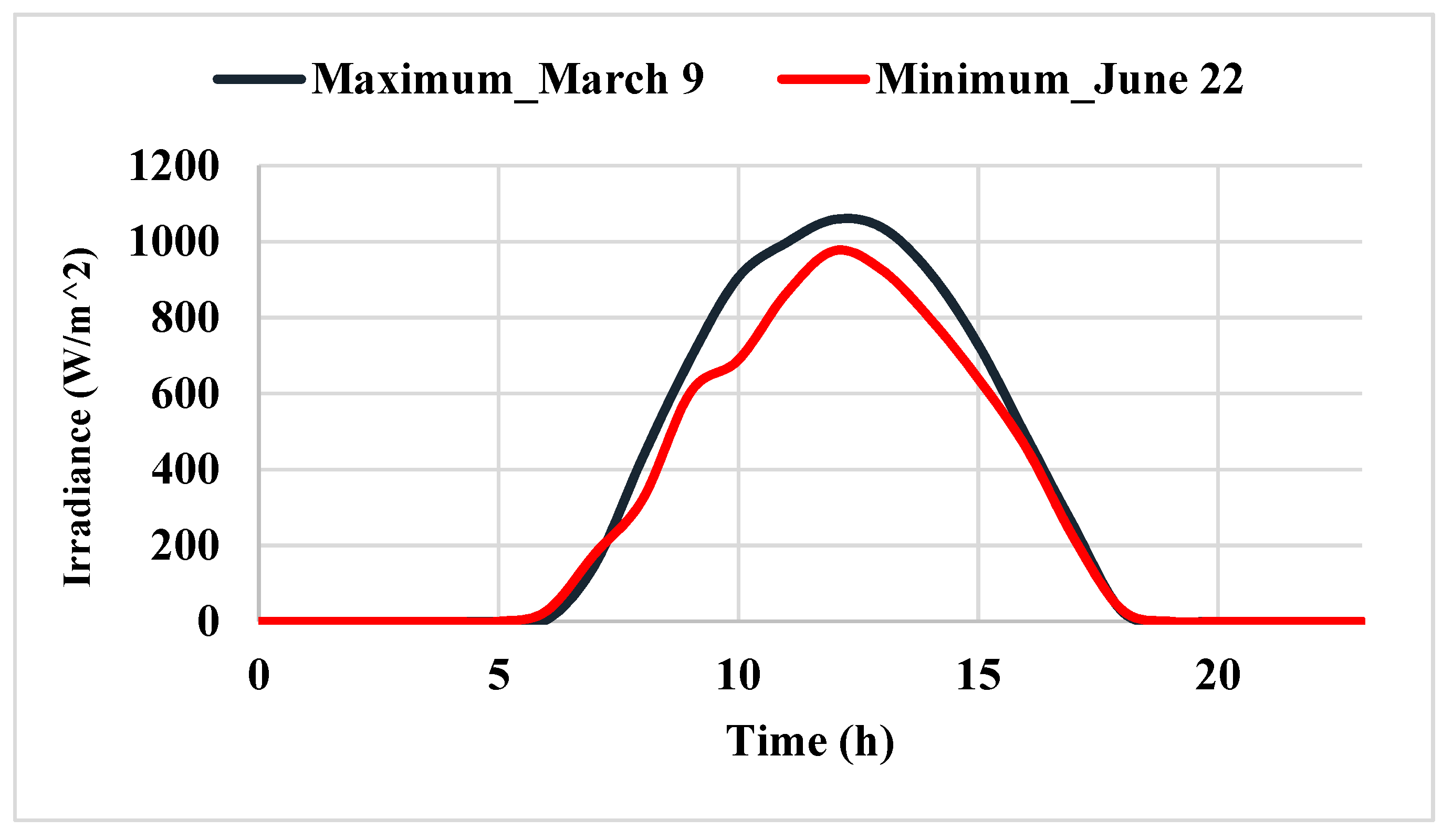
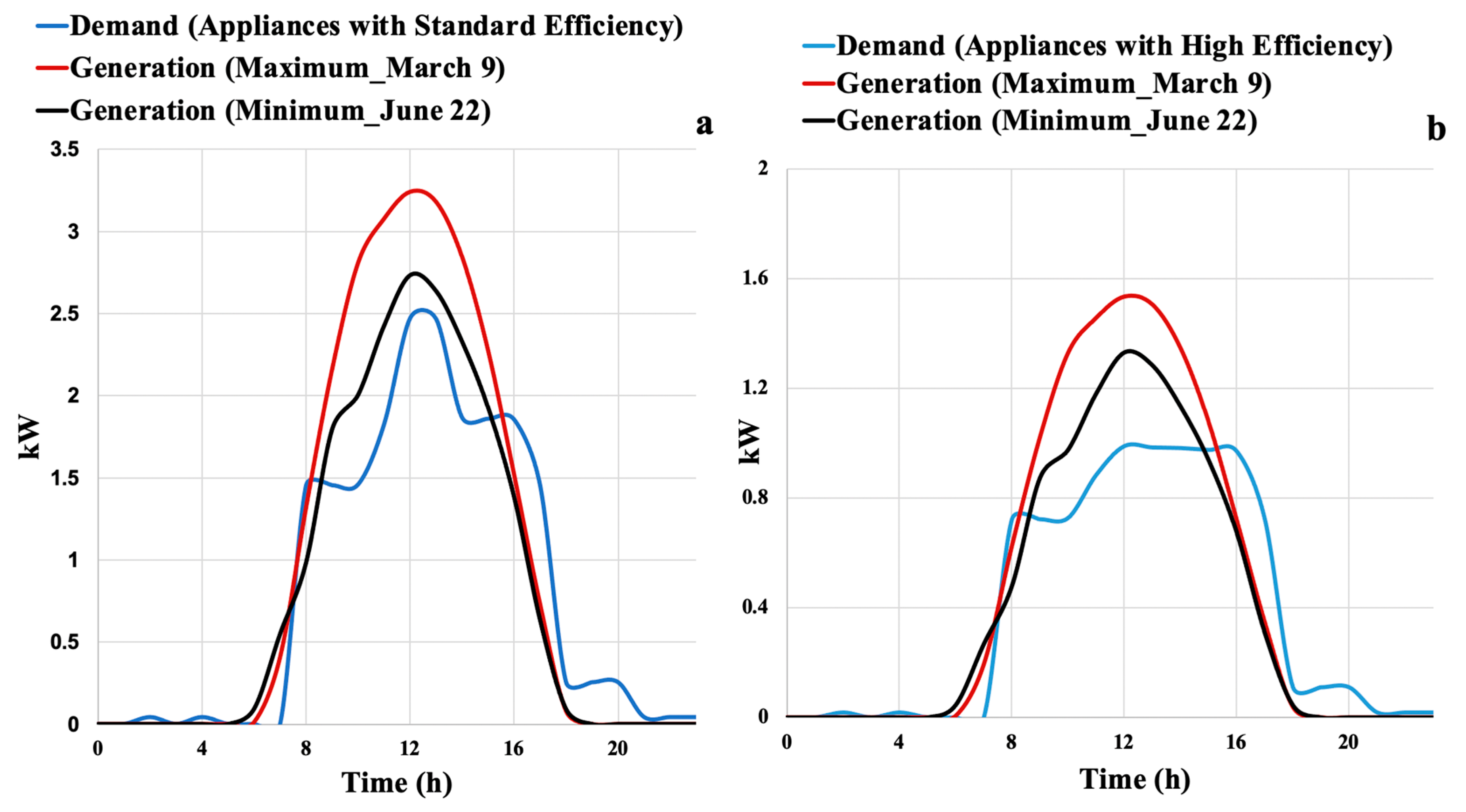

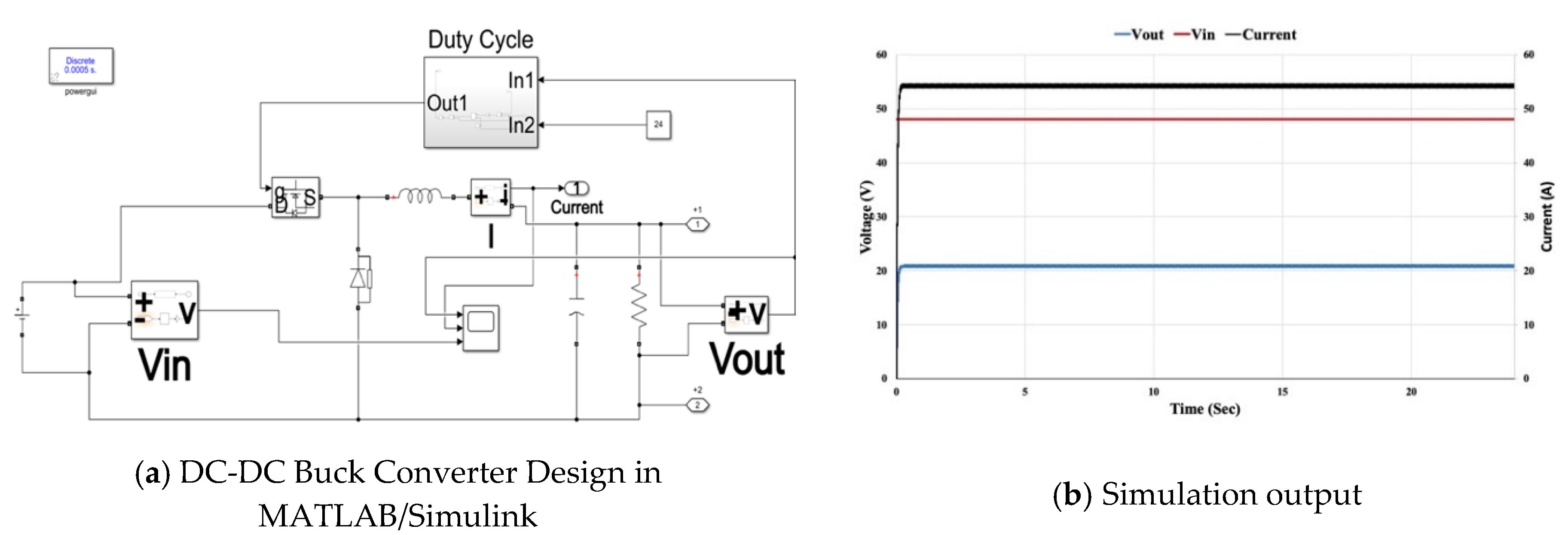

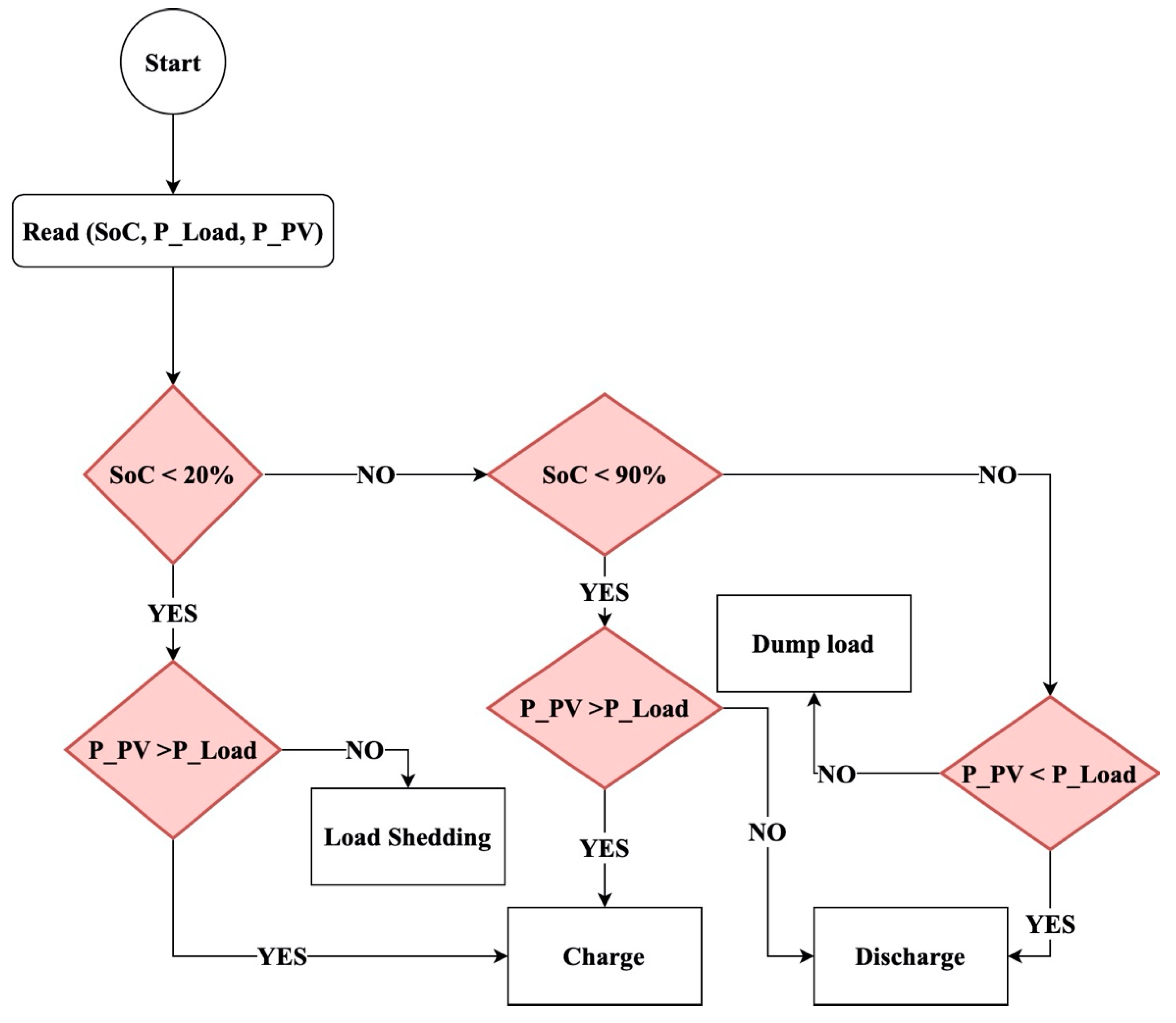



| Appliances/Services | Specification | Power (W) | Average Use Time (h/day) | Energy Consumption (Wh/day) | |
|---|---|---|---|---|---|
| Lighting/CFL Lamps | Classrooms | 11 W × 16 | 176 | 3 | 528 |
| Staff office | 9 W × 4 | 36 | 10 | 360 | |
| Director office | 9 W × 1 | 9 | 10 | 90 | |
| Security office | 9 W × 1 | 9 | 8 | 72 | |
| Outside | 11 W × 3 | 33 | 8 | 264 | |
| Computers | 200 W × 7 | 1400 | 10 | 14,000 | |
| Printer | 360 W ×1 | 360 | 1 | 360 | |
| Photocopy | 1000 W ×1 | 1000 | 2 | 2000 | |
| Fan | Ceiling fan | 35 W × 8 | 280 | 3 | 840 |
| Table Fan | 30 W × 4 | 120 | 3 | 360 | |
| Radio receiver | 5 W × 1 | 5 | 3 | 15 | |
| Mobile Charging | 3 W × 4 | 12 | 4 | 48 | |
| GSM wireless Tel | 2 W × 4 | 8 | 8 | 64 | |
| Total Power consumption | 3448 | 19,000 | |||
| Appliances/Services | Specification | Power (W) | Average Use Time per Day (h/day) | Energy Consumption (Wh/day) | |
|---|---|---|---|---|---|
| Lighting/LED Lamps | Classrooms | 5 W × 16 | 80 | 3 | 240 |
| Staff office | 3 W × 4 | 12 | 10 | 120 | |
| Director office | 3 W × 1 | 3 | 10 | 30 | |
| Security office | 3 W × 1 | 3 | 8 | 24 | |
| Outside | 5 W × 3 | 15 | 8 | 120 | |
| Computers | 100 W × 7 | 700 | 10 | 7000 | |
| Printer | 150 W ×1 | 150 | 1 | 150 | |
| Photocopy | 250 W × 1 | 250 | 2 | 500 | |
| Fan | Ceiling fan | 25 W × 8 | 200 | 3 | 600 |
| Table Fan | 12 W × 4 | 48 | 3 | 144 | |
| Radio receiver | 5 W × 1 | 5 | 3 | 15 | |
| Mobile Charging | 3 W × 4 | 12 | 4 | 48 | |
| GSM wireless Tel | 2 W × 4 | 8 | 8 | 64 | |
| Total Power consumption | 1486 | 9055 | |||
| Generation Scenario | Standard Efficiency | ||
|---|---|---|---|
| Generated Energy (kWh) | Consumed Energy (kWh) | Δ Stored Energy (kWh) | |
| Maximum | 23.66 | 19 | 1.95 |
| Minimum | 19.69 | 19 | −0.89 |
| High Efficiency | |||
| Maximum | 11.21 | 9.1 | 0.89 |
| Minimum | 9.53 | 9.1 | −0.32 |
Publisher’s Note: MDPI stays neutral with regard to jurisdictional claims in published maps and institutional affiliations. |
© 2020 by the authors. Licensee MDPI, Basel, Switzerland. This article is an open access article distributed under the terms and conditions of the Creative Commons Attribution (CC BY) license (http://creativecommons.org/licenses/by/4.0/).
Share and Cite
Aemro, Y.B.; Moura, P.; de Almeida, A.T. Design and Modeling of a Standalone DC-Microgrid for Off-Grid Schools in Rural Areas of Developing Countries. Energies 2020, 13, 6379. https://doi.org/10.3390/en13236379
Aemro YB, Moura P, de Almeida AT. Design and Modeling of a Standalone DC-Microgrid for Off-Grid Schools in Rural Areas of Developing Countries. Energies. 2020; 13(23):6379. https://doi.org/10.3390/en13236379
Chicago/Turabian StyleAemro, Yohannes Biru, Pedro Moura, and Aníbal T. de Almeida. 2020. "Design and Modeling of a Standalone DC-Microgrid for Off-Grid Schools in Rural Areas of Developing Countries" Energies 13, no. 23: 6379. https://doi.org/10.3390/en13236379
APA StyleAemro, Y. B., Moura, P., & de Almeida, A. T. (2020). Design and Modeling of a Standalone DC-Microgrid for Off-Grid Schools in Rural Areas of Developing Countries. Energies, 13(23), 6379. https://doi.org/10.3390/en13236379






